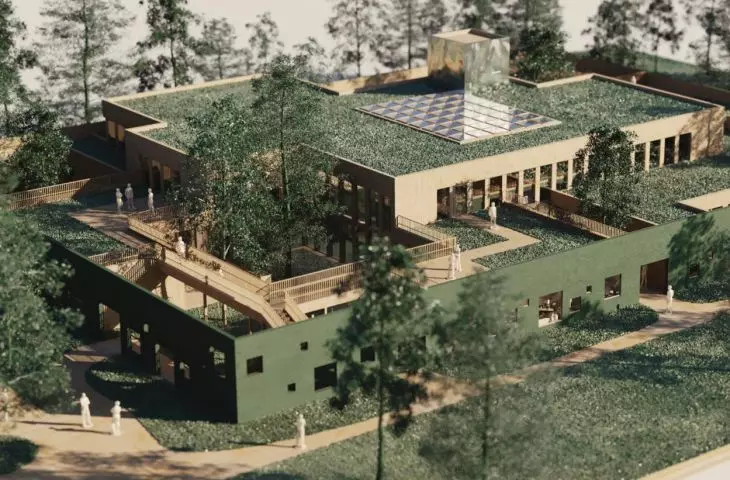Work submitted for the competition
"Best Diploma Architecture".
The school building is one of the first public spaces we come into contact with. As children, we experience it more intensely, intuitively drawing information about the world from it. School in its traditional form does not fully meet the needs of today's world. Its role should not be to provide ready-made knowledge, but to create conditions for seeking it, building social relationships and experiencing the world.
Initial analyses of the topic focused on alternative methods of education. One of them is Montessori pedagogy, which treats the school building itself as an important element of learning. It is characterized by mixed age groups, no timetable or bells. Students decide for themselves what they will do at any given time, so they enjoy learning and develop self-awareness.
The idea behind the project is to create a school as a place to learn rather than be taught. The space should follow the natural needs of children and young people, drawing on Yu-Fu Tuan's considerations in "Space and Place," create both "safe" places and "unexplored" spaces, and define the relationship between them.



diagrams
© Ewa Bubik
The way the concept is shaped comes from confronting the needs of Montessori pedagogy with the conclusions of research in environmental psychology. The layout is based on the hierarchization of space. Transitions between zones of different intimacy and accessibility are accentuated by changes in room size and height, lighting and materials. The goal was also to dispense with communication in the form of corridors and reduce vertical partitions that constitute barriers.
functional-spatial layout
The center of the establishment is an open space with a wide staircase for seating. Above it is a skylight, making it the tallest and most brightly lit part of the building. Exploratory space is scattered around the center are rooms of specialized studios: music, ceramics or chemistry. Many nooks and crannies are created between their walls.



bird's eye view
© Ewa Bubik
Mezzanines connected by footbridges are placed on the rooms. The space created in this way is an exploration section, which is meant to stimulate the desire to discover the world. It also acts as a buffer between the social and noisy center and the quiet rooms of the classrooms. Classrooms are the rooms where the ceiling is the lowest, and it is also the most private and personal place. With its quietness and orderliness, it is meant to provide a sense of security and belonging. Each classroom has a separate entrance, checkroom and restroom. The L-shaped layout divides the space into three zones and creates a field of observation in its kink.



first floor plan and cross section
© Ewa Bubik
The terraces by the classrooms close the L-shape to the square. When folded, the doors become an integral part of the rooms. Atria were created by separating the school building from the garden with an openwork wall full of square openings. The freely landscaped garden located outside the outline of the openwork wall provides an outdoor exploration zone.
form
The walls of the urban interiors were finished with wood, while the openwork wall surrounding the building from the outside was finished with green plaster. As a result, seen from the outside, the building gives the impression of floating above the surrounding greenery. Once inside the atrium, it becomes visually set on the ground.



atrium
© Ewa Bubik
The structure of the building is a combination of the main system in the form of a glulam frame and grid ceiling with subordinate elements in lightweight solid wood frame construction. The materials used in the project are mainly of natural origin. The structure of the walls and ceilings was insulated with panels and soft wood fiber mats. The façade was finished with facade boards and green tinted mineral structural plaster. In the interior, birch plywood and natural green stained linoleum were used. The extensive green roof was planted with a mix of floral meadow.
The 


the facade is finished with facade boards and green colored mineral structural plaster
© Ewa Bubik
Ewa BUBIK
Illustrations: © Author

































